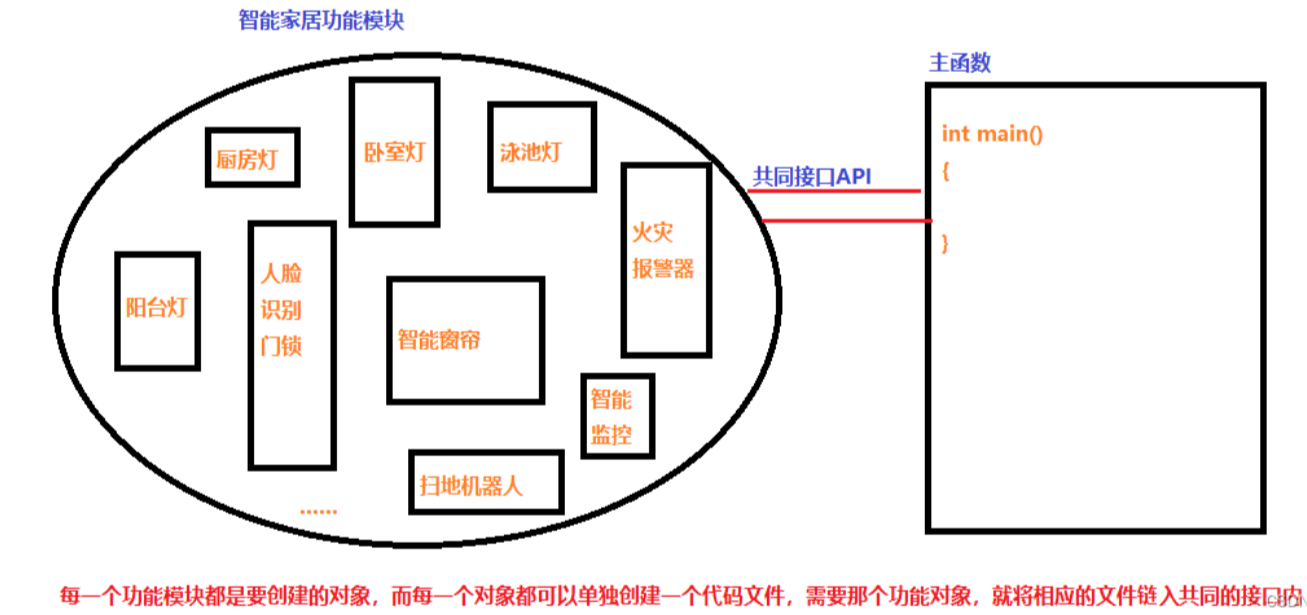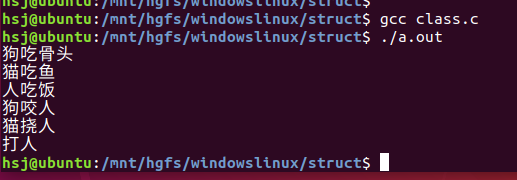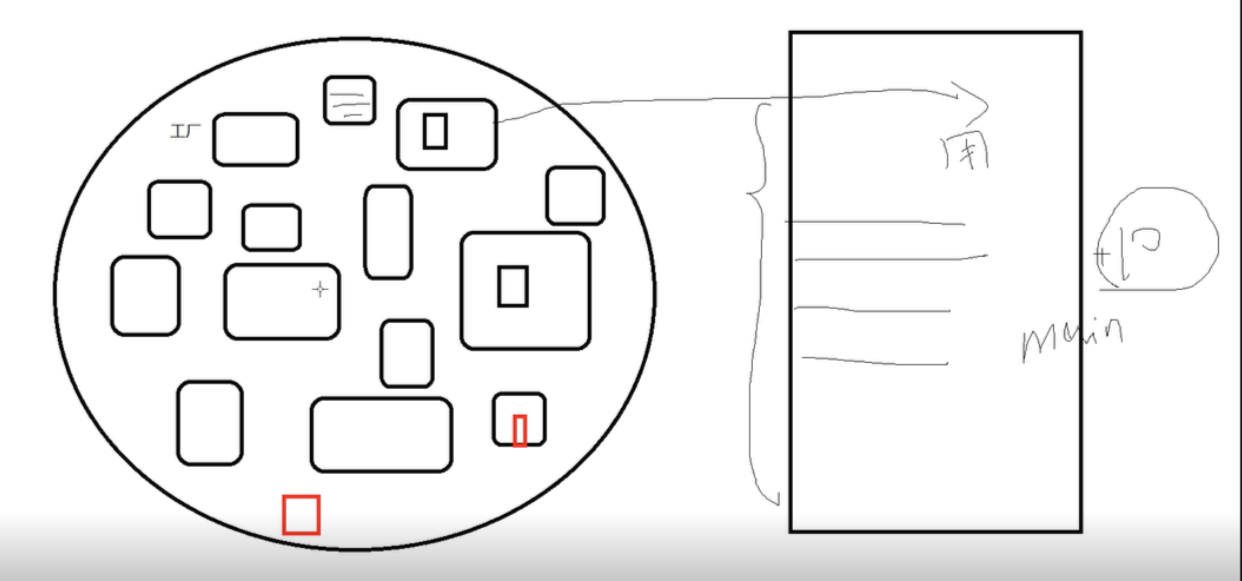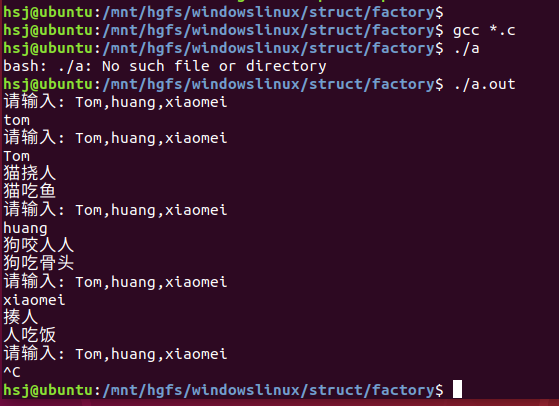| C语言简单工厂模式和工程创建 | 您所在的位置:网站首页 › c语言究竟是什么 › C语言简单工厂模式和工程创建 |
C语言简单工厂模式和工程创建
|
一,设计模式概念引入
① 什么是设计模式
设计模式通常被面向对象的软件开发人员所采用,是软件开发人员在软件开发过程中面临问题的解决方案。也是众多软件开发人员经过长时间的试验和错误总结出来的23种设计模式。虽然很多人认为C语言只是面向过程的开发,但鄙人认为此说法并不全面,难道面向对象的语言就不面向过程了吗?同理,在C语言的使用过程中一样允许面向对象。在平时代码编写中,有时会遇到修改一处BUG而影响整个代码的运行,设计模式的出现正好就解决了这一问题。
② 什么是类和对象
C语言 面向过程 也可以面向对象,还能用其设计模式,只是不太友好的面向对象 Java 面向对象 也可以面向过程,只是不太友好的面向过程 面向过程和面向对象只是代码的一种编程方式和编程思想,不应该和编程语言绑定起来 类:类是面对对象程序设计实现信息封装的基础。类是一种用户定义的引用数据类型,也称类类型。比如C语言中结构体,就是用户自己定义的一种数据类型 struct Animal{ int age; int sex; //成员属性 void (*peat)(); //函数指针 void (*pbeat)(); //成员方法 };对象:类的一种具象。每个类包含数据说明和一组操作数据或传递消息的函数。类的实例就称为对象。 dog是类Animal的一种具体对象; ● cat是类Animal的一种具体对象; ● person是类Animal的一种具体对象; struct Animal dog; struct Animal cat; struct Animal person; ③ 什么是工厂模式工厂模式是最常用的设计模式之一。这种类型的设计模式属于创建型模式,它提供了一种创建对象的(最佳)方式; ● 在工厂模式中,我们在创建对象时不会对客户端暴露创建逻辑,并且是通过使用一个共同的接口来指向新创建的对象;● 共同的接口:我们自己创建共同接口API,从工厂里面获得需要的对象放入main函数中去运行。  二,C语言工厂模式的实现
① 普通类和对象的代码实现
#include
/*类:struct Animal*/
/*对象: struct Animal dog/cat/person*/
struct Animal
{
char name[128];
int age;
int sex; //成员属性
void (*peat)();
void (*pbeat)(); //成员方法
};
void dogeat()
{
printf("狗吃骨头\n");
}
void cateat()
{
printf("猫吃鱼\n");
}
void personeat()
{
printf("人吃饭\n");
}
void dogbeat()
{
printf("狗咬人\n");
}
void catbeat()
{
printf("猫挠人\n");
}
void personbeat()
{
printf("打人\n");
}
int main()
{
struct Animal dog = {
.peat = dogeat, //部分成员赋值
.pbeat = dogbeat
};
struct Animal cat = {
.peat = cateat,
.pbeat = catbeat
};
struct Animal person = {
.peat = personeat, //对象,事物的具象
.pbeat = personbeat
};
dog.peat();
cat.peat();
person.peat();
dog.pbeat();
cat.pbeat();
person.pbeat();
return 0;
}
二,C语言工厂模式的实现
① 普通类和对象的代码实现
#include
/*类:struct Animal*/
/*对象: struct Animal dog/cat/person*/
struct Animal
{
char name[128];
int age;
int sex; //成员属性
void (*peat)();
void (*pbeat)(); //成员方法
};
void dogeat()
{
printf("狗吃骨头\n");
}
void cateat()
{
printf("猫吃鱼\n");
}
void personeat()
{
printf("人吃饭\n");
}
void dogbeat()
{
printf("狗咬人\n");
}
void catbeat()
{
printf("猫挠人\n");
}
void personbeat()
{
printf("打人\n");
}
int main()
{
struct Animal dog = {
.peat = dogeat, //部分成员赋值
.pbeat = dogbeat
};
struct Animal cat = {
.peat = cateat,
.pbeat = catbeat
};
struct Animal person = {
.peat = personeat, //对象,事物的具象
.pbeat = personbeat
};
dog.peat();
cat.peat();
person.peat();
dog.pbeat();
cat.pbeat();
person.pbeat();
return 0;
}
 ② 工厂模式代码实现
② 工厂模式代码实现
● 工厂模式不会暴露创建对象的代码逻辑,上面对象代码逻辑全部暴露无遗; ● 以上面的代码为例,以工厂模式的方式将dog,cat,person这几个对象拆分成单独的代码文件,并在每个文件中提供用来链接的函数,方便main函数的调用; 
如上图中,左侧可以比拟为一个工厂,工厂里有很多个可能,右侧可比拟一个main函数的入口,当我们用到哪个功能时, 就在main函数中调用工厂里的功能接口(API)就可以了,如果想要在工厂里建立一个新功能时,直接新添加一个文件就好,工厂中一个独立的文件就代表是一个独立的功能,各个功能之间互不干扰,比如你改错了一个功能文件,但不影响其他的功能文件。 分别创建需要的文件:  ● cat.c
#include "animal.h"
void cateat()
{
printf("猫吃鱼\n");
}
void catbeat()
{
printf("猫挠人\n");
}
struct Animal cat = {
.name = "Tom",
.peat = cateat,
.pbeat = catbeat
};
struct Animal *putCatInLink(struct Animal *phead) //头插法,会改变头,所以用到指针
{ //链表头传过来
if(phead == NULL) //如果头为空,那就返回cat为链表头
{
return &cat;
}
else
{
cat.next = phead; //否则cat的下一个为链头
phead = &cat; //再把链头指向猫
return phead;
}
};
● dog.c
#include "animal.h"
void dogeat()
{
printf("狗吃骨头\n");
}
void dogbeat()
{
printf("狗咬人人\n");
}
struct Animal dog = {
.name = "huang",
.peat = dogeat,
.pbeat = dogbeat
};
struct Animal *putDogInLink(struct Animal *phead) //头插法,会改变头,所以用到指针
{ //链表头传过来
if(phead == NULL) //如果头为空,那就返回cat为链表头
{
return &dog;
}
else
{
dog.next = phead; //否则cat的下一个为链头
phead = &dog; //再把链头指向猫
return phead;
}
};
● person.c
#include "animal.h"
void personeat()
{
printf("人吃饭\n");
}
void personbeat()
{
printf("揍人\n");
}
struct Animal person = {
.name = "xiaomei",
.peat = personeat, //对象,事务的具象
.pbeat = personbeat
};
struct Animal* putPersonInLink(struct Animal *phead)
{
if(phead == NULL){
return &person;
}else{
person.next = phead;
phead = &person;
return phead;
}
};
● animal.h
#include
struct Animal{
char name[128];
int age;
int sex; //成员属性
void (*peat)();
void (*pbeat)(); //成员方法
struct Animal *next; //涉及到链表,添加链表节点
};
struct Animal *putCatInLink(struct Animal *phead); //cat.c文件中的该函数将cat相关全局的结构体加到链表中
struct Animal *putDogInLink(struct Animal *phead); //dog.c文件中的该函数将cat相关全局的结构体加到链表中
struct Animal *putPersonInLink(struct Animal *phead); //person.c文件中的该函数将cat相关全局的结构体加到链表中
● mainpro.c
#include "animal.h"
int main()
{
struct Animal *phead = NULL; //初始化
phead = putCatInLink(phead);
phead = putDogInLink(phead);
phead = putPersonInLink(phead);
return 0;
}
● cat.c
#include "animal.h"
void cateat()
{
printf("猫吃鱼\n");
}
void catbeat()
{
printf("猫挠人\n");
}
struct Animal cat = {
.name = "Tom",
.peat = cateat,
.pbeat = catbeat
};
struct Animal *putCatInLink(struct Animal *phead) //头插法,会改变头,所以用到指针
{ //链表头传过来
if(phead == NULL) //如果头为空,那就返回cat为链表头
{
return &cat;
}
else
{
cat.next = phead; //否则cat的下一个为链头
phead = &cat; //再把链头指向猫
return phead;
}
};
● dog.c
#include "animal.h"
void dogeat()
{
printf("狗吃骨头\n");
}
void dogbeat()
{
printf("狗咬人人\n");
}
struct Animal dog = {
.name = "huang",
.peat = dogeat,
.pbeat = dogbeat
};
struct Animal *putDogInLink(struct Animal *phead) //头插法,会改变头,所以用到指针
{ //链表头传过来
if(phead == NULL) //如果头为空,那就返回cat为链表头
{
return &dog;
}
else
{
dog.next = phead; //否则cat的下一个为链头
phead = &dog; //再把链头指向猫
return phead;
}
};
● person.c
#include "animal.h"
void personeat()
{
printf("人吃饭\n");
}
void personbeat()
{
printf("揍人\n");
}
struct Animal person = {
.name = "xiaomei",
.peat = personeat, //对象,事务的具象
.pbeat = personbeat
};
struct Animal* putPersonInLink(struct Animal *phead)
{
if(phead == NULL){
return &person;
}else{
person.next = phead;
phead = &person;
return phead;
}
};
● animal.h
#include
struct Animal{
char name[128];
int age;
int sex; //成员属性
void (*peat)();
void (*pbeat)(); //成员方法
struct Animal *next; //涉及到链表,添加链表节点
};
struct Animal *putCatInLink(struct Animal *phead); //cat.c文件中的该函数将cat相关全局的结构体加到链表中
struct Animal *putDogInLink(struct Animal *phead); //dog.c文件中的该函数将cat相关全局的结构体加到链表中
struct Animal *putPersonInLink(struct Animal *phead); //person.c文件中的该函数将cat相关全局的结构体加到链表中
● mainpro.c
#include "animal.h"
int main()
{
struct Animal *phead = NULL; //初始化
phead = putCatInLink(phead);
phead = putDogInLink(phead);
phead = putPersonInLink(phead);
return 0;
}
编译说明: 多个.c文件同时编译:gcc *.c , 如果编译过程中没有报错,但是没有输出内容,是因为在manpro.c的代码中没有输出代码,但是链接成功  ● 完善mainpro.c
#include "animal.h"
#include
struct Animal *fileName(char *str,struct Animal *phead)
{
struct Animal *tmp = phead;
if(tmp == NULL)
{
printf("空\n");
return NULL;
}
else
{
while(tmp != NULL) //遍历链表
{
if(strcmp(tmp->name,str) == 0) //tmp的值和输入的名字是想等的,说明找到了
{
return tmp;
}
tmp = tmp -> next; //没找到的话就继续遍历链表
}
return NULL; //一直没找到就返回NULL;
}
}
int main()
{
char buf[128] = {"\0"};
struct Animal *phead = NULL; //初始化
struct Animal *ptmp;
phead = putCatInLink(phead);
phead = putDogInLink(phead);
phead = putPersonInLink(phead);
while(1)
{
printf("请输入: Tom,huang,xiaomei\n");
scanf("%s",buf);
ptmp = fileName(buf,phead);
if(ptmp != NULL)
{
ptmp -> pbeat();
ptmp -> peat();
}
memset(buf,'\0',sizeof(buf));
}
return 0;
}
● 完善mainpro.c
#include "animal.h"
#include
struct Animal *fileName(char *str,struct Animal *phead)
{
struct Animal *tmp = phead;
if(tmp == NULL)
{
printf("空\n");
return NULL;
}
else
{
while(tmp != NULL) //遍历链表
{
if(strcmp(tmp->name,str) == 0) //tmp的值和输入的名字是想等的,说明找到了
{
return tmp;
}
tmp = tmp -> next; //没找到的话就继续遍历链表
}
return NULL; //一直没找到就返回NULL;
}
}
int main()
{
char buf[128] = {"\0"};
struct Animal *phead = NULL; //初始化
struct Animal *ptmp;
phead = putCatInLink(phead);
phead = putDogInLink(phead);
phead = putPersonInLink(phead);
while(1)
{
printf("请输入: Tom,huang,xiaomei\n");
scanf("%s",buf);
ptmp = fileName(buf,phead);
if(ptmp != NULL)
{
ptmp -> pbeat();
ptmp -> peat();
}
memset(buf,'\0',sizeof(buf));
}
return 0;
}
编译结果: C语言简单工厂模式完成! 
|
【本文地址】